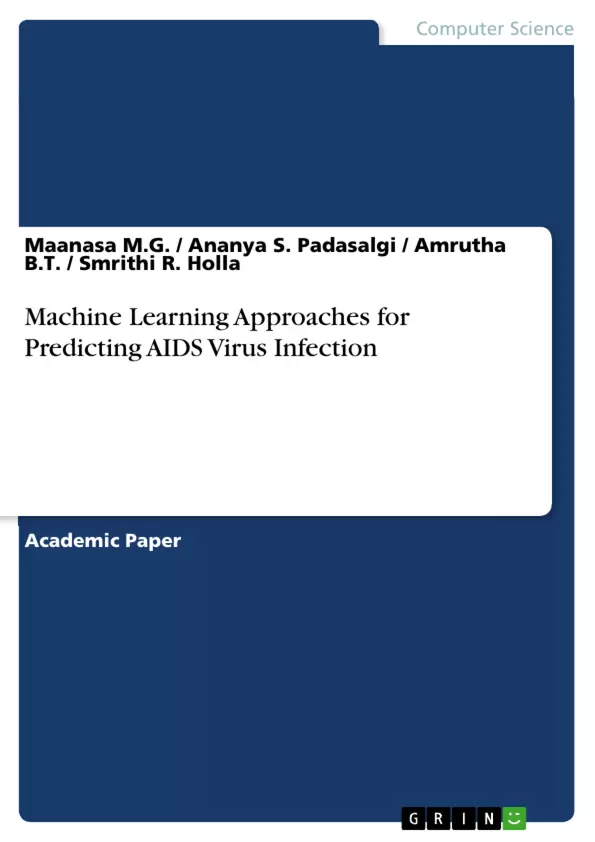This review investigates the use of machine learning approaches, notably Random Forest and Neural Network classifiers, in the context of AIDS classification and digit identification using the MNIST dataset.
The paper compares the performance of a Random Forest classifier and a Multi-Layer Perceptron (MLP) neural network on an AIDS classification dataset, emphasizing the significance of feature scaling and the impact of model design on classification accuracy. The Random Forest model was used to determine feature relevance, and the MLP classifier was trained and tested for accuracy in categorizing the binary outcome of HIV infection.
Inhaltsverzeichnis (Table of Contents)
- I. INTRODUCTION
- II. METHODOLOGY
- 1. Data Collection and Preprocessing
- 2. Model Development
- 3. Performance Evaluation
- 4. Feature Importance Analysis
- 5. Comparison of Classifiers
- 6. Implementation and Deployment
- Random Forest Classifier Overview
- Applications in HIV Prediction
- Confusion Matrix: A Comprehensive Tool for Evaluating Disease Prediction Models
- Understanding the Confusion Matrix
- Application in HIV/AIDS Prediction
- Neural Networks in Disease Prediction: A Review
- Introduction
- Understanding Neural Networks
- Application in HIV/AIDS Prediction (Neural Network)
- DataFrames: Pandas provides the notion of two-dimensional, labeled, tabular data structures with columns that potentially hold different data types. They may be viewed as spreadsheet-kind data or SQL tables, hence very natural to deal with and analyze
- Data Manipulation: Pandas will let you manipulate your data in a variety of ways, including filtering, grouping, merging, reshaping, and much more. It is in these capabilities that the library finds its strength in cleaning and preprocessing data before it is used in training machine learning models. Panda provides reading and writing to a large variety of file formats, such as CSV, Excel, JSON, and several others.
- Numpy('np'):
- III. COLAB SETTING FOR MACHINE AND DEEP LEARNING
- Importing necessary Libraries:
- Python Libraries:
- Matplotlib('plt'):
- Seaborn('sns'):
- Machine learning Models:
- Scikit-learn('sklearn'):
- Deep Learning Models:
- IV. RESULT & EXPLANATION
Zielsetzung und Themenschwerpunkte (Objectives and Key Themes)
The main objective of this paper is to explore the use of machine learning approaches, specifically Random Forest and Neural Networks, for predicting HIV/AIDS infection using clinical and demographic data. The paper aims to demonstrate the effectiveness of these models in improving diagnostic accuracy and assisting healthcare professionals in making more informed decisions.
- Comparison of Random Forest and Neural Network Classifiers in HIV/AIDS prediction.
- Evaluation of model performance using metrics like accuracy, precision, recall, and F1-score.
- Importance of feature selection and data preprocessing for enhancing model performance.
- Application of the confusion matrix for evaluating the accuracy and effectiveness of classification models in disease prediction.
- Potential for integrating feature selection techniques with advanced neural network models to improve predictive performance in medical diagnostics and image categorization.
Zusammenfassung der Kapitel (Chapter Summaries)
The paper begins with an introduction to HIV/AIDS, outlining its global impact and highlighting the need for improved diagnostic tools. The methodology section details the steps involved in collecting and preprocessing the data, developing the Random Forest Classifier and neural network models, and evaluating their performance. Chapter summaries are provided for the Random Forest Classifier, its applications in HIV prediction, and the Confusion Matrix. The paper concludes with a review of Neural Networks and their applications in disease prediction.
Schlüsselwörter (Keywords)
The main keywords and focus topics of this paper include machine learning, Random Forest, Neural Networks, HIV/AIDS prediction, confusion matrix, feature importance analysis, data preprocessing, and Google Colab.
- Quote paper
- Maanasa M.G. (Co-author), Ananya S. Padasalgi (Co-author), Amrutha B.T. (Co-author), Smrithi R. Holla (Co-author), 2024, Machine Learning Approaches for Predicting AIDS Virus Infection, Munich, GRIN Verlag, https://www.hausarbeiten.de/document/1500198


